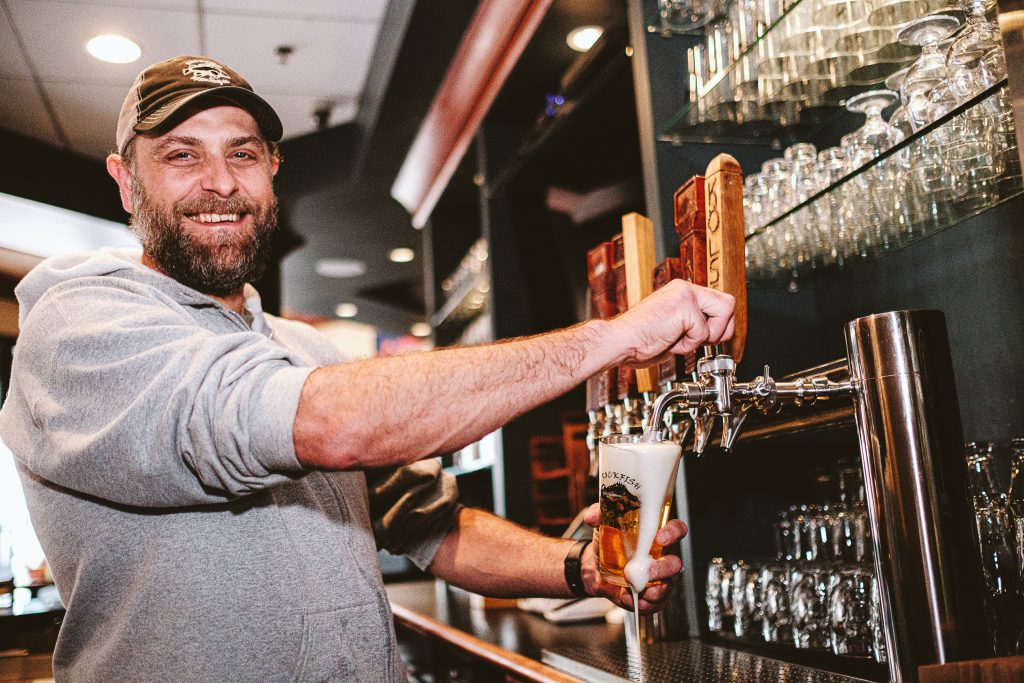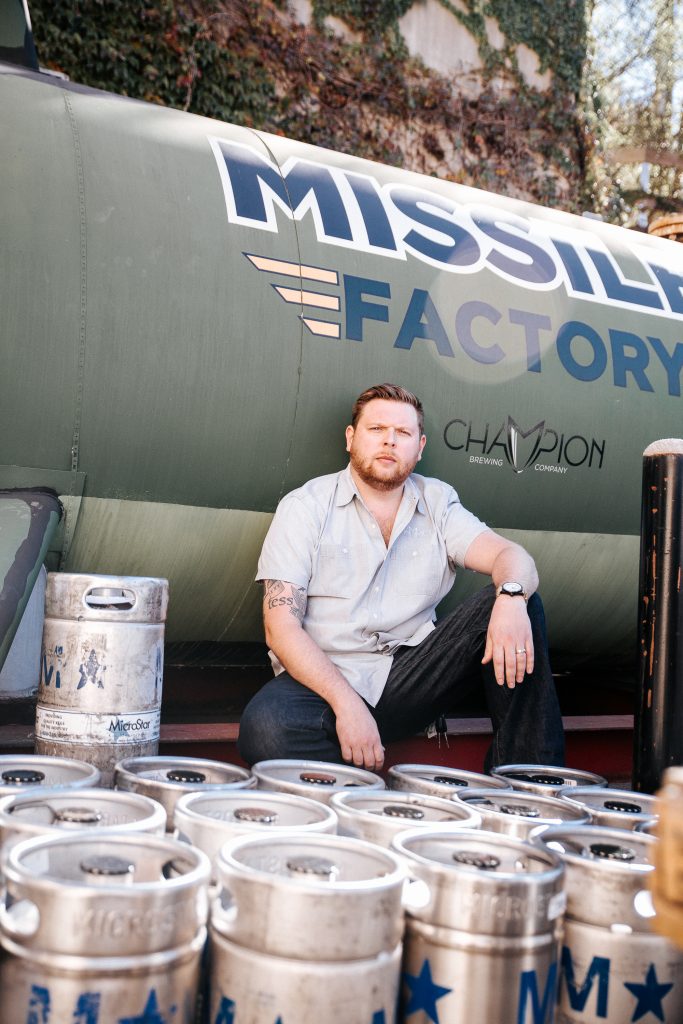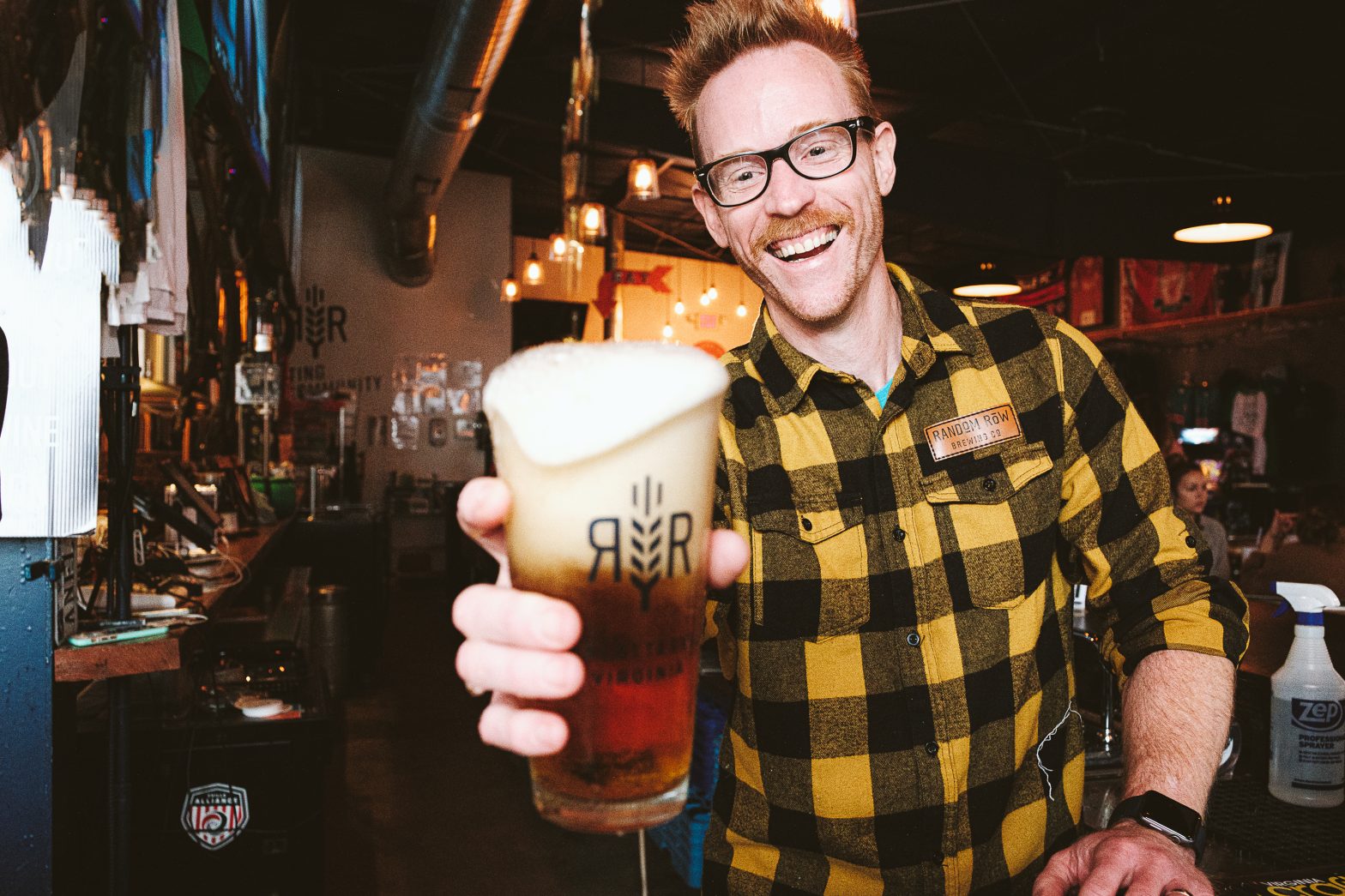Brewing beer is about control: controlling ingredients, controlling processes, controlling product.
But it’s also about deciding when to let go.
Take Three Notch’d Brewing Company. It started small, with brewmaster Dave Warwick, supported by a team of four administrators, making a few hundred barrels of craft beer per year at their Preston Avenue home.
At the time, in 2013, Warwick controlled a lot of what was going on. He brewed the beer and helped with market research, administrative tasks, marketing, and accounting.
As his company grew, Warwick had less control over the Three Notch’d brew-niverse. He began delegating responsibilities, and the change seems to have worked to the brewery’s advantage. 3NB now has a full accounting department, HR director, six-person marketing department, chief growth officer, VP of sales, and VP of retail. “That allows me to focus just on the liquid,” Warwick says. “Not wearing as many hats is great for both me and the company.”
Today, 3NB is the largest beer producer inside Charlottesville city limits by a wide margin. In-town brewers produced about 17,500 barrels of beer last year, with Three Notch’d accounting for roughly 15,000. At 31 gallons per barrel, that’s 542,500 gallons of beer produced in 2022—enough to fill 85 percent of an olympic-size swimming pool. Or enough to send 4.34 million pints sliding over the bartop.
The production number should tick up in 2023 to 23,500 barrels, with most Charlottesville breweries increasing production numbers and at least one small brewer expected to go online.
In other words, that olympic-size swimming pool will overflow by 60,000 gallons by the end of the year. Charlottesville drinkers will have access to nearly 6 million pints within a 10.3-square-mile area.
“There’s something really special about being able to go to a neighborhood brewery and drink a beer that was packaged literally an hour before you’re drinking it,” says Josh Skinner, director of brewing operations at Selvedge Brewing, Charlottesville’s nano-est craft operation. “I think people recognize the value in that, and it’s why our industry has enjoyed continued enthusiasm and support from the community we serve.”

Dialing in
Can craft beer makers control their production numbers? Sure, to a certain extent. But they’re also beholden to market demand and, increasingly, supply chain and distribution issues.
Craft beer production and consumption totals are projected to increase substantially nationwide in the next year. This prediction is inconsistent with recent trends, according to Keith Clark, central Virginia sales director for Virginia Eagle Distributing Co.
Clark says the past several years saw craft beer slowly leak its “share of throat” as new drinks percolated. That doesn’t mean craft beer is shrinking, but it’s not growing at nearly the clip it did over the previous decade.
Hard seltzers were first to encroach on beer’s share, then it was ready-to-drink cocktails in cans, with seltzers taking a slight dip downward. “That’s not to say seltzers aren’t still doing extremely well,” Clark says. “It’s just not the hot new thing anymore.”
Brewers Association national beer sales and production data indicate craft beer continued its “long and unsteady recovery in 2022,” with retail sales back to pre-pandemic levels but “draught beer … still recovering.” In 2021, the last full year for which the association has comprehensive data, total U.S. beer sales were essentially flat, but craft volumes ticked up by 8 percent, raising small and independent brewers’ market share to 13.1 percent. Production volume showed similar 2021 growth, with overall beer ticking up 1 percent and craft growing 7.9 percent. Craft beer’s retail dollar sales also grew in 2021, to $26.8 billion. Analysts, though, say the increase was mostly due to consumers paying more for brew in bars and restaurants than they did in stores in 2020.
The Brewers Association reports 9,247 breweries operated nationwide in 2021. Five hundred fifty opened in 2022, but at least 200 closed. Brewery openings topped off in 2018, while closings reached a head in 2020, largely due to COVID-19. Even so, closure rates had increased every year since 2013, regardless of the C-word’s effect.
Charlottesville wasn’t immune to the trend, and after years of industry expansion, a well-regarded local shop, Reason Beer, closed its doors. Reason’s closing came about in no small part due to a star-crossed merger with Champion Brewing Company. “Our facility merger at the beginning of last year was so snake-bitten from the start when it comes to lead times and supply chain issues out of our control,” says Champion owner Hunter Smith.
Defying the openings trend locally was Rockfish Brewing Company, which launched a second nano-brewery and taproom last year on the Downtown Mall. This year, Neon Culture Brewing has a chance to launch a two-barrel system capable of brewing 500 barrels annually—though owner Corey Hoffman says he will likely continue operating at a low level out of the Decipher brewhouse—and SuperFly Brewing Co. expects to get off the ground and pump out up to 400 barrels.
“Without having been open, there already seems to be some enthusiasm in town for it,” says Ed Liversidge, SuperFly owner and operator. “I certainly think there is a town full of people willing to come and try new beer. I know that’s how I feel about it. I’ll always go check out the new place.”
Liversidge says he plans to carve his niche in the local taproom market as he goes, using consumer feedback to find the beers that resonate most. It’s a move that gives away a lot of control to beer drinkers.
But maybe central Virginia beer lovers are special, and maybe Charlottesville can support more breweries per capita than most small towns. After all, Richmond has the fourth-most breweries per capita in the country (25 breweries, for 10.77 per 100,000 residents), according to Move.org.
“All the small breweries here are quite different, and there are things I like about each of them,” says Liversidge, whose background and brewing lineage has taken him from the U.K. to the U.S. West Coast and now Virginia.

Taking on challenges
Smith opened the Champion taproom doors adjacent to downtown Charlottesville in 2012. Times were simple then. Get raw materials, make unique beer, sell it across the bar. But Champion grew quickly, and with rapid growth came control issues.
One solution? Retake control of the environment in which consumers enjoy beer. For Smith and Champion, that meant featuring restaurants in their expansion strategy. The approach sidesteps Virginia’s sometimes tricky distribution regulations and ensures the product arriving at a beer-lover’s table is the one the brewer intends.
Enter COVID. Restaurant closures meant folks could only consume beer in their homes. Restaurants like Champion Grill in The Shops at Stonefield and the brewery’s Lynchburg location closed in 2021. Then, late last year, Champion announced a major distribution move, shifting its ale allocation to Bevana, a North Carolina-based company launched by former Champion principal Levi Duncan.

The latest wave of Charlottesville breweries, including Random Row Brewing Co., Decipher Brewing, Rockfish, Selvedge, and the still-to-come SuperFly, have all sidestepped beer distro challenges by sticking to taproom-only sales. Each ballparks its packaged to-go brewshare at around 10 percent of overall sales. That includes only hand-bottled or canned offerings and growlers/crowlers filled at the tap.
“I don’t really have much of a desire to distribute,” says Peter McMindes, Rockfish owner and head brewer. “There’s legislation out there to allow small breweries to self-distribute; then we’d be able to put some specialty bottles out to local bottle shops. But we’re not dealing with economies of scale or volume that makes distribution worthwhile.”
Supply chain issues are another story. The pandemic and an industry-wide drift away from bottled beer set off a can shortage two years ago. Now cans seem to be back, but brewers face the same raw materials cost increases as business owners do in nearly every economic sector.
“I’m getting emails from all our suppliers, from grain to hops to CO2, saying they have to raise prices, and we can’t just keep raising ours to the point that we price ourselves out of the market,” says Brad Burton, co-owner and head brewer for Decipher.
According to Skinner, sourcing malt from local malster Murphy & Rude has softened the blow of rising freight costs. Still, Random Row’s Kevin McElroy says he’s had to up prices due to hop cost increases. German and Czech hops in particular will be pricier and scarcer throughout 2023 after poor harvests last year.
Staffing is another issue befuddling brewers, but Burton says properly run nano-shops are uniquely suited to combat inevitable HR issues. “We were in the best possible spot we could have been in the shutdown,” he says. “We didn’t have any employees or distribution. The brewers that had large distributions took the brunt of the hit, because there was zero beer going out in kegs and being sold to restaurants. Just managing growth—that’s what gives you a sustainable model.”
Burton doesn’t expect to see further contraction in the craft brewing industry—people have been talking about a “bubble” for a decade, he says—and other brewers around town tend to agree. Breweries are notoriously helpful to one another, and the taproom sales model keeps locations from competing for shelf space. Warwick, who does have to worry about shelf space constraints, also points out the lack of competition between 3NB and the nanos. “That’s why it’s easy to be friends, get along, and help each other grow,” he says.
Smith, whose distribution at its height reached farther than any other Charlottesville-proper brewery, believes the industry is finally beginning to stabilize. Brewers can now forecast raw material pricing and need, not to mention consumer demand, he says. “Keg sales came back, but it’s not the same, and it may never be the same,” he says. “There was a point at which every restaurant had to become a beer bar. Now bars and restaurants are saying they don’t necessarily need 20 taps to make their customers happy. It’s more competitive for those taps, but volume is climbing back.”
After all the chaos of the last several years, maybe some sense of control is back.

Tippling with trends
For his part, McMindes isn’t willing to give up control when it comes to flavor-of-the-week preferences. “We don’t do trendy stuff,” the Rockfish owner says. “We don’t even name our beers. And our logo doesn’t have anything to do with beer.”
McMindes says he went into brewing because he couldn’t find anything on the market as good and suited to his own taste as he made on his homebrew system. It’s a familiar hubris that has led to the downfall of many well-meaning hobbyists-cum-pros. But McMindes might be onto something by emphasizing personal taste.
In McMindes’ mind, nano breweries have more control than anyone else in the beer biz. They aren’t beholden to growth or profits. They can listen to their customers right over the bar, taking the hard work out of market research.
For breweries that do follow trends, Clark says the one that stands out above all others is consumers looking to control themselves—by drinking non-alcoholic beer. “Our Anheuser-Busch rep showed me the NA numbers in Europe, and I was like, ‘There is no way,’” Clark says.
The trend has certainly spread across the Atlantic. Clark says Virginia Eagle ran out of its NA portfolio during the past Dry January, a now-annual tradition when sober-curious folks give up the alcoholic goods.
Smith notes that non-alcoholic beer has become tastier due to the ever advancing science behind it, and drinkers who would never before reach for an O’Doul’s or St. Pauli NA now select near beer over hazy IPAs, adjunct stouts, and fruited sours.
These days, not only are the national guys getting into the NA game, but the locals are going buzz-free as well. 3NB looks to lead the mocktail barrage in Charlottesville. Warwick says the brewery doesn’t know yet how much NA will constitute its production this year, but he and his team launched the non-alcoholic Uncool brand in January with plans to expand.
Non-alcoholic drink demand is echoed in a trend several local brewers point out—a growing gusto for lagers at 4.0-range ABVs rather than IPAs in the 6s and above. Burton, for one, is all about that lager life.
But NA fanaticism flies in the face of another trend that has the attention of local brewers: relatively high ABV cocktails in cans. Even though it ain’t beer, the big guys like 3NB and Champion are launching ready-to-drinks to grab a share of the latest drinking deluge.
Clark says he’s seeing some of today’s price-conscious consumers going to the extreme on lager love, rejecting the skyrocketing price of craft beer and rediscovering quaint macros like PBR. Warwick says he hasn’t seen the same.
“My favorite thing about craft beer is that the loyalty isn’t so much to brands as it is to style,” Warwick says. “Craft beer drinkers share the love … and everything I see is people will still gladly pay extra for flavor, quality, and to support local brewers and craft.”
McMindes notes that, locally, most breweries have gone the Champion route and try to control the downstream consumption environment by running restaurants instead of taprooms only. His approach? Stay on brand. Reject the trend.

Finding a balance
Even Charlottesville’s beer can’t be controlled.
Yes, we know citywide production should be about 23,500 barrels next year. But we also know that crouched just outside of town are major brewing industry tigers who stand to top that production by at least five-fold.
Starr Hill, opened by Mark Thompson in downtown Charlottesville in 1999 before craft beer was cool, can reportedly dump nearly 30,000 barrels annually from its Crozet and Roanoke brewhouses. Devils Backbone, purchased by A-B InBev in 2016 to the chagrin of beer nerds, boasts production of 84,000 annual barrels. And Blue Mountain, whose owner Taylor Smack also runs South Street Brewing downtown, makes almost 3,000 barrels per year.
Several other players dot the 151 corridor—Thompson’s Brewing Tree, WildManDan Brewery, Hazy Mountain—which has become a destination for beer lovers, many of whom have no idea what’s going on down the road in Charlottesville.
“That corridor is only getting busier and busier,” Warwick says—and 3NB is looking to get in on the 151 action; the team has purchased the assets of the former Wild Wolf Brewing Company and plans to run it under its own label. “It’s such a destination,” Warwick says. “It’s definitely the hub in Virginia for amazing alcoholic beverages, from wine to beer to hard cider to distilling, even mead.”
When Smith launched Champion, he in fact wanted his brand to be a foil to the big players right outside town. Starr Hill, Blue Mountain, and Devils Backbone had seen so much success selling lagers; he and Champion would carve their niche in unique ales and one-off releases. “We used to joke that we never needed to brew a single lager beer,” Smith says.
That outlook has changed, Smith admits, as so many things have on the local beer scene. For years, Champion was the biggest brew producer inside city limits. The company pushed its Woolen Mills Missile Factory, named after the brewery’s flagship IPA, to a 15,000 barrel capacity in 2016, with lagers a major part of the mix.
But last year, Smith and Champion moved the production site outside town. The new brewery was “essentially a construction site” most of the year, Smith says, brewing only 2,500 barrels in 2022. This year, Smith expects the number to be back up to nearly 7,000.
For Champion, other things over the last several years were beyond control. The closure of two Champion Hospitality Group restaurants was only the culmination of the group’s supply chain and consumer demand issues.
“Expansion through restaurants has always been something that we had hoped to do in partnership. We are a brewery. We are not restaurant experts,” Smith says. “But I have to laugh. Expanding through restaurants when we did was a stroke of bad luck.”
Smith says the future is under control, though, and it’s a sentiment that’s reflected by brewers all across the hamlet.
“Last year was really tough,” Smith says. “But without going into great detail, keep watching. We are not done.”
